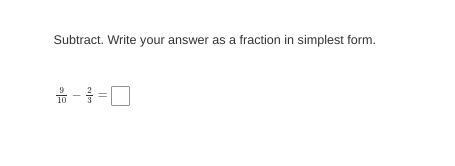Subtract \( \frac{9}{10} - \frac{2}{3} = \) and write your answer as a fraction in simplest form.

Understand the Problem
The question is asking us to subtract the fraction ( \frac{2}{3} ) from ( \frac{9}{10} ) and to express the answer in its simplest form.
Answer
The result is \( \frac{7}{30} \).
Answer for screen readers
The answer is ( \frac{7}{30} ).
Steps to Solve
- Find the Least Common Denominator (LCD)
To subtract the fractions ( \frac{9}{10} ) and ( \frac{2}{3} ), first find the LCD of the denominators (10 and 3).
The multiples of 10 are: 10, 20, 30, ...
The multiples of 3 are: 3, 6, 9, 12, 15, 18, 21, 24, 27, 30, ...
The LCD is 30.
- Convert the Fractions
Now, convert each fraction to have the common denominator of 30.
For ( \frac{9}{10} ): $$ \frac{9}{10} = \frac{9 \times 3}{10 \times 3} = \frac{27}{30} $$
For ( \frac{2}{3} ): $$ \frac{2}{3} = \frac{2 \times 10}{3 \times 10} = \frac{20}{30} $$
- Subtract the Fractions
Now that both fractions have the same denominator, subtract them:
$$ \frac{27}{30} - \frac{20}{30} = \frac{27 - 20}{30} = \frac{7}{30} $$
- Simplest Form
The result ( \frac{7}{30} ) is already in its simplest form, as 7 and 30 have no common factors.
The answer is ( \frac{7}{30} ).
More Information
The subtraction of fractions requires a common denominator to combine the numerators. This demonstrates how fractional operations work in terms of equivalence.
Tips
- Forgetting to find a common denominator before subtracting.
- Simplifying the fraction incorrectly after subtraction.
AI-generated content may contain errors. Please verify critical information